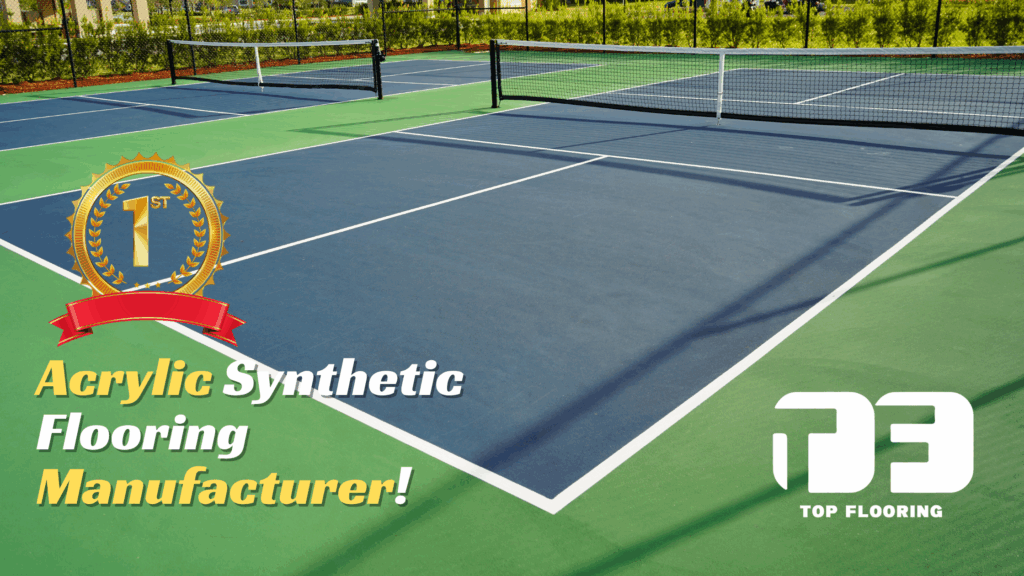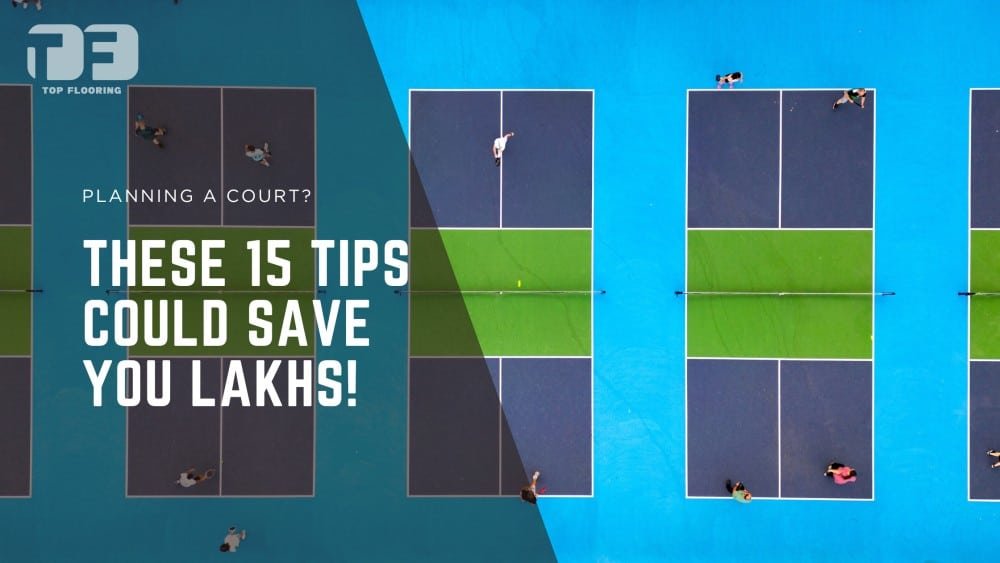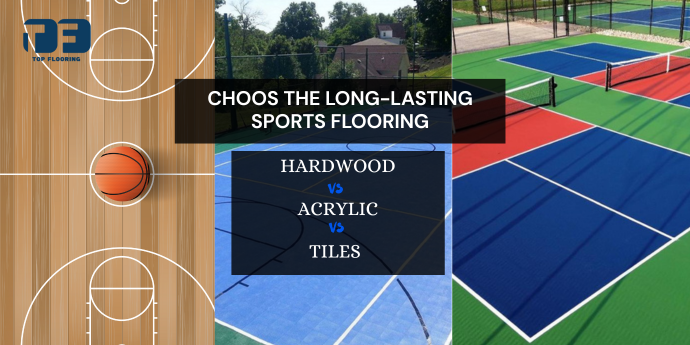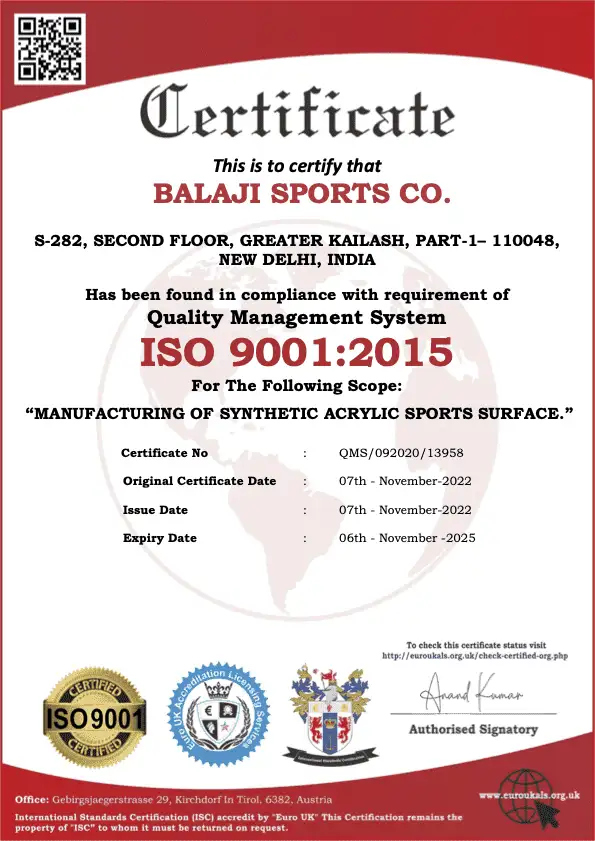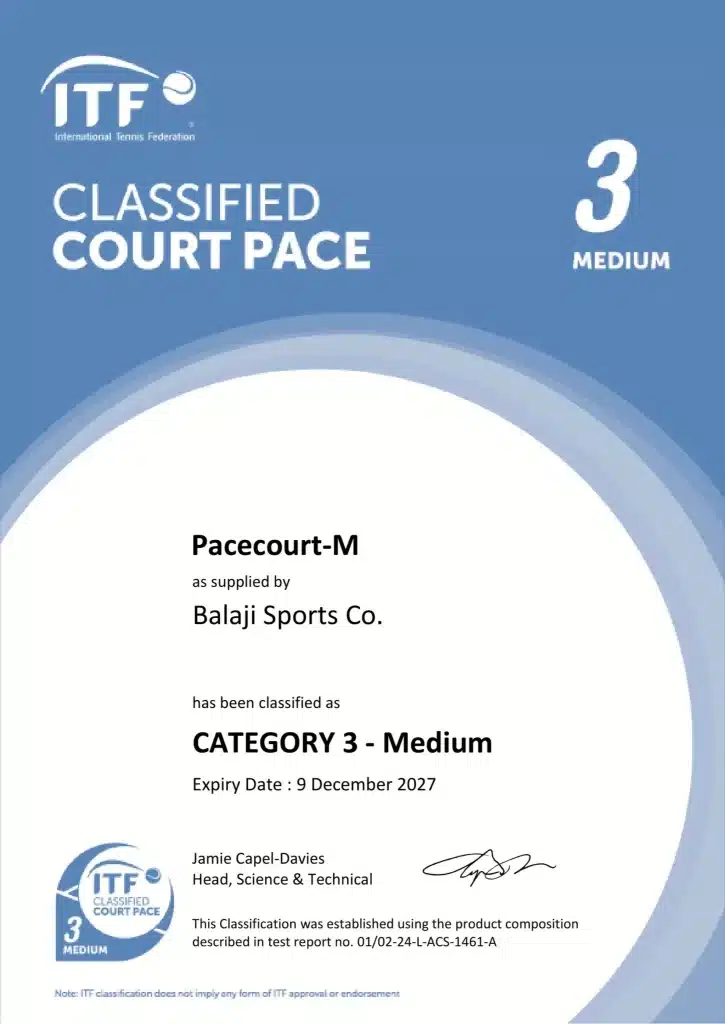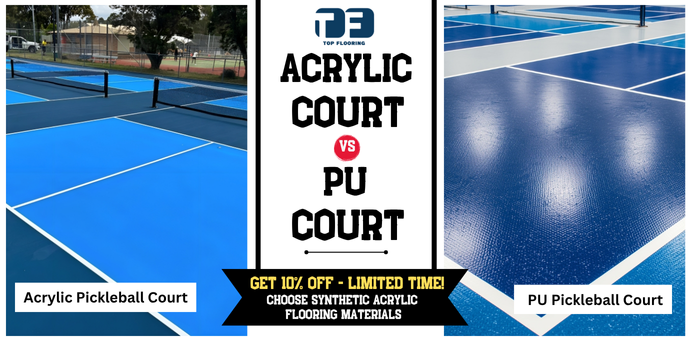
From clubs and housing societies to rooftop courts and resorts, pickleball is redefining how people socialize and stay active. But beneath every exciting rally lies one crucial foundation is the court surface. The flooring of a pickleball court determines how the ball will bounce, players movement and how long the surface will last before maintenance is needed. Acrylic vs PU Flooring or any other flooring for pickleball court. Every flooring requires precise control and quick reflexes, even minor differences in grip, texture or bounce which affect the game.
In India’s climate where scorching heat, heavy rain and humidity test a surface. And the two top contenders for pickleball flooring are Acrylic vs PU (Polyurethane). Both have established reputations in pickleball court construction but serve different purposes and environments. This guide by Top Flooring, India’s trusted name in synthetic sports flooring materials, covers every key difference: composition, installation, comfort, cost and performance. It also takes you step by step through how pickleball courts are actually built so you’ll know exactly what makes a surface perform and last.
Whether you’re a school planner, club owner or society committee member, this comparison will help you choose a surface that delivers professional playability, durability and real world value.
What Is Acrylic Flooring, And Why Does It Suit Pickleball Courts?
Acrylic flooring is a multi layered, water based synthetic coating system designed for outdoor sports. It consists of acrylic resins, color pigments, elastomeric compounds and silica sand for texture. Each layer serves a technical purpose from priming and sealing the concrete to providing cushion and vibrant color.
Components of an Acrylic System:
- Primer: Seals pores and enhances adhesion.
- Acrylic Resurfacer: Smoothens the base, fills hairline cracks.
- Cushion Coats (optional): Provides shock absorption and player comfort.
- Color Coats: Delivers UV resistant color and perfect texture.
- Line Marking: ITF standard finishing for game markings.
Acrylic systems can be customized using Top Flooring 5 layer, or 8 layer configurations depending on whether the court is for recreational or tournament use. They are non toxic, quick drying, slip resistant and can withstand extreme temperatures.
What makes acrylic flooring ideal for pickleball is the balance of firmness and flexibility. The surface has enough elasticity to cushion player movement while maintaining the hard court response that ensures a true ball bounce.
For Indian projects which are exposed to harsh sun and unpredictable rain. Acrylic flooring by Top Flooring is the most reliable option. It’s weatherproof, low maintenance and available in colours like blue green or terracotta red so you get performance and aesthetics.
What Is PU (Polyurethane) Flooring — A Closer Look?
PU flooring, short for Polyurethane, is a synthetic elastomer system designed for indoor sports complexes. It’s made of liquid polyurethane compounds that cure into a smooth, rubber-like surface over a solid base like concrete or rubber mats.
PU Flooring Features:
- It offers seamless and joint-free finish.
- PU flooring provides good shock absorption.
- It is comfortable for long playing sessions.
- Elastic for indoor training spaces.
But PU flooring doesn’t perform well in outdoor conditions. Continuous exposure to UV rays can cause yellowing and softening, while trapped moisture can create bubbles and surface cracks. In indoor spaces like gyms or multi-purpose halls PU is great. It’s soft, comfortable and good for badminton or fitness sessions. But when used outdoors for pickleball PU’s weakness shows up. It can’t handle long term heat, dust or rain.
For outdoor pickleball courts PU isn’t designed for India’s climate. Due to premature fading, surface deformation and higher maintenance costs. That’s why Top Flooring recommends PU only for indoor recreational projects, while acrylic flooring is the proven choice for open-air pickleball courts.
How to Choose the Perfect Court Surface for Better Gameplay: Acrylic vs PU flooring
When building or upgrading a pickleball court flooring the surface quality defines the player’s confidence, control and comfort. Every rally, spin and serve depends on how the ball behaves on the floor. A court that’s too hard strains joints; one that’s too soft absorbs momentum. The challenge is to find a flooring system when comparing acrylic vs PU flooring choose the one that balances bounce, grip and cushioning—and that’s where material choice matters.
Acrylic Flooring: Precision and Predictability
An acrylic pickleball surface gives you that balance which is required during play. The ball response is medium paced, clean and consistent, rallies feel natural and predictable. And the ball doesn’t skid or lose momentum. It rebounds smoothly and players can anticipate each return. The fine silica texture on the topcoat gives players a confident grip firm enough to allow quick stops and slides, gentle enough to avoid abrasions. Players can pivot, lunge and accelerate without worrying about slips or discomfort. Moreover, the cushioned layers within the acrylic system absorb shock effectively. And reduces fatigue and joint stress during long matches or training sessions.
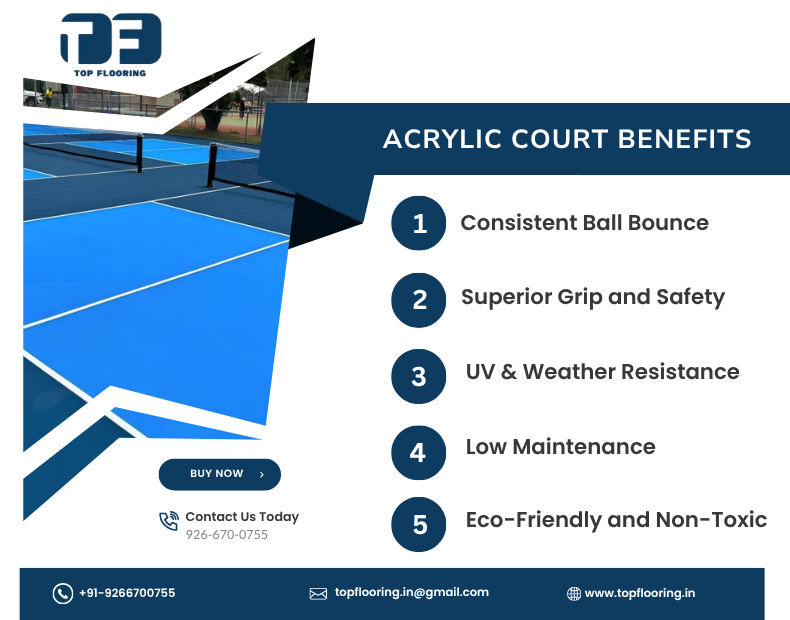
PU Flooring: Comfort but Compromise
PU (Polyurethane) flooring is a different surface. The surface feels soft and elastic, comfortable underfoot, something players love indoors. But that same softness reduces energy return, slows down the bounce and changes the pace of play. For pickleball where every millisecond counts, that can break the rhythm of the rally. PU flooring’s smoother surface also struggles with traction during quick direction changes, especially in humid or dusty conditions. The result is a surface that is comfortable but less controlled.
In short, acrylic flooring is an extension of the game itself, firm, responsive and built for rhythm. PU is friendly but lacks the precision that competitive players demand. For courts that need to perform for outdoor pickleball court surfaces, withstand heat and offer reliable bounce every day. Acrylic flooring is the smarter, performance driven choice. It’s the system trusted by Top Flooring across India’s sports academies, schools and residential projects for one simple reason: it feels like the game.
Weather Resistance & Durability Under Indian Conditions: Acrylic vs PU flooring
A pickleball court doesn’t just need to play well it needs to survive the Indian climate. From scorching summers to heavy monsoons, the surface faces challenges every season. This is where choosing a weather tolerant material like acrylic makes all the difference. A court built right can last over a decade.Where as if built wrong it may start to fade or crack within a few years.
Acrylic Flooring Durability
Acrylic systems are scientifically engineered for the outdoors. The coatings are infused with UV stable pigments and high grade binders that resist sunlight and color fading. Even under intense heat the surface remains cool to touch and never turns sticky or brittle. Top Flooring’s acrylic formulations are designed to expand and contract slightly with temperature changes. So the surface remains firm, bright and functional year after year even under open sun or heavy rain. When maintained and resurfaced every few years an acrylic pickleball court can last 10 to 12 years while retaining its bounce and color integrity.
PU Flooring Durability
PU flooring however struggles under the same conditions. Constant exposure to UV rays breaks down its surface layer causing it to yellow, soften and eventually crack. During monsoons the material tends to trap moisture which leads to blistering and peeling. Its elastic structure makes it prone to expansion and contraction. So over time the smooth pickleball court surface starts to deform. In dry regions PU flooring can even become brittle losing its cushioning properties entirely. Outdoors it rarely lasts beyond five to six years even with regular maintenance.
For Indian climates where courts are open air and exposed to all weather conditions acrylic is the best option. Its UV stability, water proof finish and easy pickleball court resurfacing process makes it the most cost effective long term choice for builders and facility managers. Top Flooring’s acrylic coatings are designed for Indian weather conditions, combining durability with beauty. Courts built with these systems stay vibrant, safe and game ready season after season. So players and property owners can be confident their investment will last for years to come.
How to Build a Pickleball Court with Acrylic Flooring
A professional-grade pickleball court requires layering precision. Here’s the breakdown from Top Flooring experts:
Base Preparation:
Every great pickleball court starts with a solid base. The process begins with base preparation, using high-quality concrete (M25 grade) or asphalt pickleball court flooring. And the surface must be fully cured, crack-free and built with a 1% slope to allow water to drain naturally. Any uneven patches or visible cracks are filled and levelled. That makes sure the sub-base is smooth before coating begins. This stage is critical as even the best pickleball court flooring system can’t perform well on an uneven base.
Primer:
Once the base is ready, a primer is applied. This bonding agent acts as a bridge between the concrete and the acrylic layers above it, sealing pores and improving adhesion. Without this, the coating will lift or peel over time.
Acrylic Resurfacer:
After priming, the next step is to apply the acrylic resurfacer, a mixture that fills microcracks, hides imperfections and creates a smooth finish. The resurfacer also ensures even absorption of subsequent layers, giving the court a professional feel.
Cushion Coats (Optional):
For advanced pickleball court installations especially for clubs, academies or heavy-use areas cushion coats are added next. These are 2–5 layers of elastomeric compounds that provide resilience and comfort underfoot. They absorb impact and reduce joint fatigue, making gameplay safer and more enjoyable. Cushion systems are one of the reasons acrylic courts feel responsive yet forgiving, especially in high-intensity matches.
Color Coat:
Once the cushion base is set, color coating brings the court to life. Two coats of UV-resistant acrylic paint are applied, providing traction and vibrant color. These coatings come in ITF-approved shades like green, blue or terracotta which retain their color even under harsh sunlight.
Line Marking:
The final step is line marking where the standard pickleball court layout 20 feet by 44 feet is measured and painted. Accuracy in this stage ensures professional alignment, correct boundaries and true play conditions.
Final Inspection:
After the coatings have healed, final inspection is done to check for uniform thickness, even texture and slope. The court is tested for bounce response, surface friction and overall finish quality. Top Flooring’s experts handle every stage from base leveling to the final layer to ensure each project meets both aesthetic and technical standards. Depending on the court size and location, the entire process takes around 4-6 days without compromising on quality.
While PU flooring follows a multi-layer approach, it requires strict humidity control and longer curing time which makes it less practical for Indian outdoor conditions. Acrylic systems are faster to install, easier to maintain and perfect for the Indian climate.
Building a pickleball court requires the right materials, method, and mindset. With Top Flooring’s advanced acrylic technology, you’re not just constructing a sports surface; you’re creating a long-term investment in performance, aesthetics, and player safety.
Cost and ROI Analysis: Where Acrylic Outperforms PU
Cost is more than price per square foot — it’s about lifespan, maintenance, and downtime.
| Feature | Acrylic Flooring | PU Flooring |
| Installation Cost | ₹75–₹110/sq ft | ₹150–₹220/sq ft |
| Installation Time | 4–6 days | 7–10 days |
| Maintenance | Low | Moderate |
| Lifespan | 10–12 years | 6–8 years (indoor only) |
| Recoating Cycle | 5–7 years | 4–6 years |
| Ideal Location | Outdoor & Indoor | Indoor only |
While PU costs almost twice as much, it doesn’t deliver twice the durability. Acrylic systems from Top Flooring offer the best ROI with lower installation cost of pickleball court, less maintenance and more play hours per year.
For builders, schools and housing societies, acrylic flooring gives higher long term returns, fewer complaints and enhanced facility reputation.
Maintenance & Upkeep: Keeping the Acrylic vs PU flooring Game-Ready
A well built pickleball court flooring can last over a decade. But only if it is maintained with the same care it was built with. Regular upkeep not only preserves the surface’s looks but also ensures consistent ball bounce, proper traction and long term safety. Even the most durable materials need attention and pickleball courts are no exception. A few simple habits can make the difference between a court that looks new for years and one that fades or cracks prematurely.
Acrylic Flooring Care
The beauty of an acrylic pickleball court lies in its low maintenance and weather resilience. But to keep the game ready throughout the year, you need to follow a few best practices. Start with regular cleaning. Dust, leaves or sand that accumulates on the surface can affect traction and make the court look dull. Sweeping or blowing off debris once a week with a soft bristled broom or leaf blower keeps the surface clean without scratching it. This simple step also prevents the buildup of organic matter that can stain the court during monsoon months.
Occasionally clean the court with a gentle wash with water and a mild non-foaming detergent. Avoid high pressure hoses or acidic cleaners as they can erode the texture coat over time. The goal is to rinse off dirt while preserving the friction and matte finish that players rely on. Never use metal brushes or harsh scrubbing tools. They can gouge the surface or remove the silica particles that create grip. Soft brushes or microfiber mops work best for removing stubborn marks.
Acrylic surfaces are designed to be non-porous and water resistant, meaning they don’t allow moisture to seep through the coatings. But periodic inspection is still necessary. Every 6 months check for cracks, bubbles or areas where the paint has worn off. Address small imperfections early to prevent them from spreading. If minor cracks appear they can be sealed with resurfacer compounds before recoating.
And finally every 5-7 years the court needs a fresh color coat. This will restore the court’s original looks and grip and UV protection. Recoating doesn’t require a full rebuild — just a quick clean and two new color layers. With these habits an acrylic court will remain as smooth, safe and looking new as the day it was built.
PU Flooring Care
Unlike acrylic, PU (Polyurethane) surfaces need more maintenance, as they are softer and more sensitive to the environment. Regular mopping and waxing is required to maintain shine and traction. Over time PU floors lose their sheen due to dust and foot traffic; waxing brings back the shine but has to be done carefully to avoid slipperiness.
Moisture is a big concern. PU floors should never be left wet for long periods, as water can seep through seams and weaken the bond between layers. Once moisture gets trapped, it can lead to discoloration or bubbling. So it’s important to ensure good ventilation and quick drying after cleaning.
PU surfaces also need specialized chemical cleaners for polyurethane coatings. Generic detergents or acidic solutions can damage the finish, creating uneven patches or making the surface sticky. Professional grade PU cleaners maintain flexibility and prevent the floor from hardening over time.
Since PU flooring is more elastic, it’s also more prone to surface dullness and micro-abrasions. To restore its original look, the surface needs to be re-polished every 12 months. This involves applying a fresh protective layer that revives gloss but adds to long term maintenance cost. For indoor spaces it’s manageable — but for outdoor pickleball courts it’s time consuming and expensive.
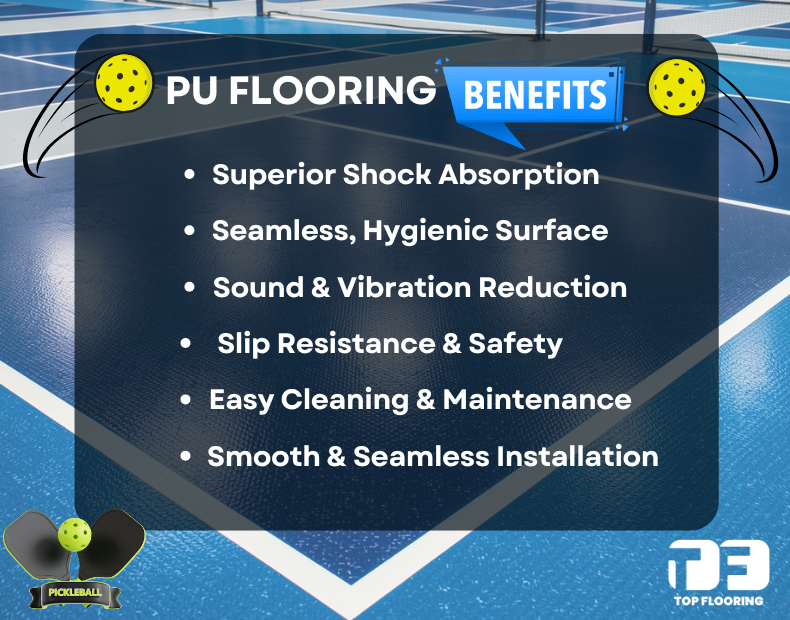
Top Flooring’s Advantage: Support That Lasts Beyond Installation
At Top Flooring, the relationship doesn’t end once the court is built — it continues through every stage of its life cycle. We offer complete after-installation support, including resurfacing guidance, authentic acrylic synthetic materials and technical consultation for repair or restoration.
Dealers across India supply genuine acrylic primers, resurfacers, cushion coats and color paints, so owners can easily maintain or upgrade their courts using the same quality materials as the original installation. Whether it’s a quick touch up or a full recoat, Top Flooring provides guidance on how to maintain bounce consistency, surface texture and visual appeal.
With the right care and genuine products, a Top Flooring acrylic court remains as good as new years later. That’s the difference between a standard surface and a professionally supported one — a court that continues to perform, inspire and endure season after season.
Comfort, Safety, Environment in Acrylic vs PU flooring
Sports flooring is no longer just about performance — it’s about player safety and the planet. A great pickleball court is where athletes feel comfortable, supported and safe throughout the match, and builders can be sure the materials used are eco-friendly and non-toxic.
Safety & Comfort
Acrylic flooring systems are designed to offer the perfect balance of comfort and safety. The micro-textured surface provides consistent grip without being abrasive, allowing players to make quick lateral movements, fast turns and controlled slides without slipping. The fine-grain texture ensures friction remains consistent across the entire court even in slightly humid or dusty conditions. This is critical for outdoor pickleball where sudden changes in speed or movement can cause slips or falls.
Underneath the surface cushion coat layers (5-layer and 8-layer systems) act like invisible shock absorbers. They reduce knee strain and muscle fatigue, so players can play longer sessions without discomfort. Whether it’s a professional academy or a housing society’s recreation court, this feature makes play safer and more enjoyable.
In contrast PU flooring is softer but compromises on traction under outdoor conditions. When moisture or heat builds up the rubberized texture becomes unpredictable and grip becomes uneven or slippery. For high speed outdoor rallies this is a real safety concern.
Environmental Impact
From an environmental perspective Acrylic flooring wins again. It’s completely water-based and VOC compliant, it doesn’t emit any fumes or odour during or after installation. PU floors are solvent-based and release higher VOCs and require controlled disposal to avoid soil or water contamination.
Top Flooring champions sustainability at every step. All its acrylic coatings are lead-free, non-toxic and recyclable, supporting India’s green construction initiatives. By choosing Top Flooring’s systems, builders are not just building courts, they’re building safer communities and a cleaner environment.
Customization, Aesthetics & Brand Presentation: Acrylic vs PU flooring
Performance is important but in today’s design conscious world, looks matter just as much. A pickleball court is often a focal point — whether in a residential society, a sports academy or a resort — and its look defines the space. This is where Acrylic flooring excels, combining stunning looks with professional playability. Unlike PU surfaces which are limited in color stability outdoors, acrylic coatings are highly customizable and fade resistant. Top Flooring offers over a dozen ITF approved color combinations — from bright blue and olive green to terracotta red — that not only add visual appeal but also help players distinguish zones clearly. The UV stable pigments ensure that even after years of sun exposure the court looks fresh and dynamic.
Acrylic flooring gives sports architects and property developers creative freedom. It allows for multi-tone zones, club logos, sponsor branding and custom markings. The smooth matte finish looks great under natural light, so it’s a preferred choice for schools, clubs and builders who want every court to be a showcase of their property’s quality. In contrast PU flooring has limited outdoor design flexibility. The color options are mostly confined to indoor neutral tones like grey or maroon. And it fades or yellows outdoors so branding is limited.
Top Flooring goes beyond material supply — it provides complete design consultation. From the initial color layout and logo positioning to the final line marking, every detail is guided by experts to ensure the court looks and performs. The result is a surface that plays well and looks great, reinforcing the property’s premium image.
Why Acrylic Over PU Flooring?
When comparing Acrylic vs PU flooring, both have their uses — PU is good for indoor controlled environments and Acrylic is good for outdoor. But for pickleball, a sport built on precision, pace and rhythm, one clear winner emerges.
Acrylic flooring provides true and consistent ball bounce so every rally feels sharp and predictable. It’s UV and weather resistant so it can withstand India’s harsh sun, heavy rains and humidity. Maintenance is minimal, installation is faster and recoating is cost effective — so it’s a long term option. PU may feel comfortable initially but its limited durability and outdoor instability makes it a short term option at best.
The difference becomes even more clear when you look at lifespan and value. An acrylic pickleball court lasts 10 to 12 years with periodic resurfacing, while PU needs replacement after 5 to 6 years. Acrylic’s low maintenance and enduring brightness means more ROI for academies, clubs and real estate projects.
Top Flooring’s acrylic coatings are not just products — they are the result of years of research, field testing and engineering refinement. These systems have been applied on hundreds of Indian courts, from Delhi’s housing societies to Bengaluru’s academies and have consistently exceeded expectations in performance and player satisfaction.
So if you are planning to build or resurface a pickleball court, Acrylic Flooring is the professional’s choice — durable, beautiful and designed for India’s climate. It’s trusted by contractors, coaches and athletes across the country because it delivers what the sport demands: consistency, safety and performance.
When you choose Top Flooring you are not just laying a surface — you are building trust, longevity and a lasting symbol of quality. Every bounce, every step and every rally on an acrylic court is proof that some choices really stand the test of time.
Conclusion
A great pickleball experience begins with great flooring. PU flooring may be good for controlled indoor environments but India’s climate demands resilience — and that’s where Acrylic flooring stands alone. From strength to texture to cost to sustainability Acrylic systems deliver on every parameter. They give true playability, long life and low maintenance — backed by Top Flooring’s nationwide dealer network and technical expertise.
Top Flooring is leading India’s sports infrastructure revolution — manufacturing ITF certified, eco friendly and performance tested acrylic flooring systems for pickleball, tennis, basketball and more. Whether you are building for a school, society or commercial facility, choose the flooring that wins rallies and lasts years.
Frequently Asked Questions
Acrylic flooring is a water-based outdoor coating known for its durability, UV resistance, and true ball bounce, while PU (polyurethane) flooring is a synthetic indoor system offering higher comfort and elasticity. Acrylic performs better outdoors, whereas PU suits climate-controlled indoor courts.
Acrylic flooring is the best choice for outdoor pickleball courts. It resists heat, rain, and UV rays, ensuring consistent grip and bounce in all weather.
PU flooring offers a softer, cushioned feel underfoot due to its elastic structure. However, acrylic cushion systems with multiple elastomeric layers can match that comfort while providing better outdoor performance and weather durability.
Yes. Acrylic flooring costs 30–40% less per sq. ft. than PU and requires minimal maintenance. It also offers a longer lifespan outdoors, giving higher ROI for sports builders and academies.
PU flooring is not recommended for outdoor use. Continuous UV exposure and moisture can cause yellowing, bubbling, or surface cracks.

